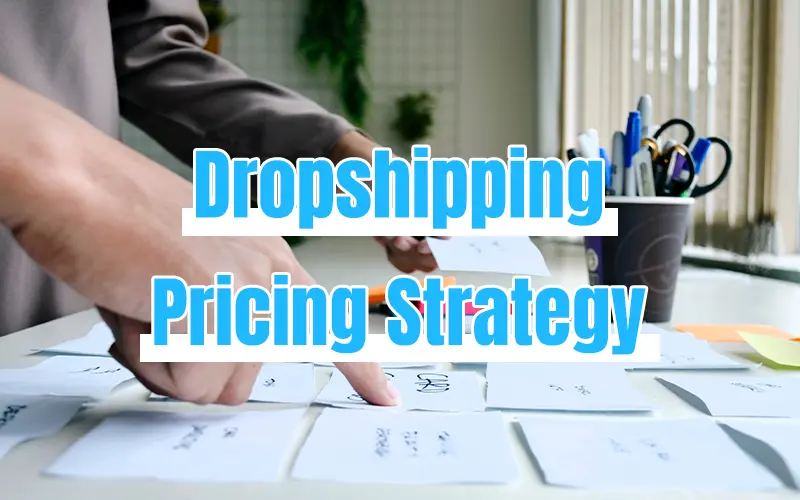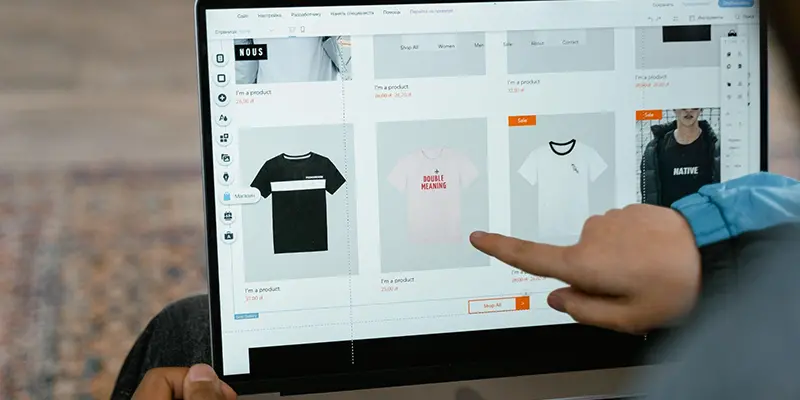Setting the proper dropshipping pricing strategy is critical for your business’s success in the fast-paced and competitive industry. Understanding pricing tactics and factors influencing price selections can substantially affect your profitability. Moreover, they can help you remain ahead of your competitors.
In this post, we will look at the art of dropshipping pricing, pricing techniques, and the factors that affect your price selections. In addition, to assist you in getting started, we’ll list some of the finest inexpensive dropshipping providers in 2023.

Page overview:
What is Printing Fulfillment Service and How Does It Works?
18 Best Printing Fulfillment Services
▼
Understanding Dropshipping Pricing

Pricing is a critical component of having a profitable dropshipping business. Before delving into particular price tactics, it’s imperative to understand the fundamentals of dropshipping pricing.
Understanding these components will provide a solid foundation for an efficient pricing plan. This plan can help maximize earnings and position you to outperform the competition in the volatile dropshipping industry.
Cost analysis is the first and most important stage in developing your dropshipping pricing strategy. It entails a detailed analysis of all expenses for running your dropshipping business. These costs usually include:
- Product Costs: It’s the cost of purchasing items from your vendors. Remember the wholesale price you pay for each product when determining your rates.
- Shipping Fees: Shipping expenses can greatly influence your profit margins. Shipping costs can vary depending on your shipping contracts with suppliers and the geographical location of your customers. When setting your product prices, keep these costs in mind or attach a separate shipping cost at checkout.
- Marketing Expenses: Marketing is vital for bringing consumers to your dropshipping store. Advertising, social media marketing, influencer partnerships, and other promotional efforts should all factor into your price.
- Operational Costs: These include all expenses for running your dropshipping business. It includes web hosting, payment processing fees, customer service, and other overhead costs.
Understanding your cost structure is critical as you can determine the minimal price for each product to avoid operating at a loss. You can calculate a baseline pricing that covers your expenses and creates profit by adding a modest markup to your product prices.
The dropshipping industry is constantly evolving, affected by consumer tastes and rising trends. It is critical to undertake frequent market trend analyses to remain competitive. It entails maintaining current industry trends and recognizing which items are in great demand.
You can find popular items by researching market patterns and altering your pricing accordingly. High-demand items can frequently fetch higher pricing. Doing so can allow you to profit from their popularity. On the other hand, products with deteriorating sales patterns can demand more competitive pricing to sustain sales.
Market trend research allows you to remain ahead of the curve and make proactive price decisions. It also assists you in identifying possibilities to launch new items or capitalize on rising trends ahead of your competition.
Here are a couple of tips for successful market trend analysis:
- Google Trends: Google Trends is the best free tool to understand market trends. Search specific keywords related to your niche, changing the location and period. Doing so will create a graph indicating the rise or fall in the keyword search in Google’s search engine. Hence, you can find the potential of your product while also finding the best-selling products in your niche.
- TikTok and Social Media: TikTok’s short-form video content gained popularity on other social media platforms. This medium allowed influencers and content creators to promote products and influence the market trend easily. Thus, search niche keywords on these platforms to understand the product’s popularity and sellability.
- Dropshipping Marketplaces: Popular dropshipping marketplaces such as eBay and Shopify can also help in market trend analysis. Feed your product in the search bar and analyze how in demand your product is. If the sellability is low, so are the chances of your product performing well in the market.
Competitor Research
Another important aspect of knowing the dropshipping price is competitor research. Your competitors have a large influence on the price environment in your niche. You can acquire significant insights into market dynamics and customer expectations by extensively researching how your competitors price their items.
During competitor research, pay attention to the following aspects:
- Price Points: Examine the prices at which your competitors sell comparable items. Doing so can provide you with an overview of the price standards in your industry.
- Unique Selling Proposition (USP): Determine any distinguishing qualities or benefits your competitors highlight in their product descriptions. Understanding your competitors’ USPs can help you properly promote your items and justify your price.
- Discounts and Promotions: Keep track of your competitors’ continuous or recurrent discounts and promotions. This data might assist you in developing promotional tactics and competitive pricing.
Understanding your competitors’ pricing tactics will allow you to fine-tune your own strategy and obtain a competitive advantage. You can offer more competitive rates, provide better value through packaged packages, or position your items as premium solutions with higher costs and more perks.
Pricing Strategies for Dropshipping Success

Choosing the proper pricing plan as a dropshipping business owner is imperative for success and retaining a competitive advantage in the market. Each approach has advantages and disadvantages; understanding them will enable you to make educated decisions to maximize earnings and accomplish corporate objectives. Let’s look into the many price techniques for dropshipping success:
1. Cost-Plus Pricing
Cost-plus pricing is a simple method that entails adding a specified markup to the cost of your goods to arrive at the selling price. The markup covers your targeted profit margin and all expenditures, ensuring you make a respectable profit on each transaction.
Cost-plus pricing promotes pricing transparency, making it simple to compute and execute. It guarantees that your firm stays financially sustainable by accounting for all costs.
While cost-plus pricing ensures a profit, it does not account for market demand or competitor price. Pricing only on cost can result in lost chances to maximize earnings during strong demand or competitive advantage.
2. Competitive Pricing
Setting your product prices in line with or slightly below the prices of your competitors is what competitive pricing entails. The goal is to attract price-conscious customers who actively evaluate costs before buying. This approach seeks a competitive edge by delivering comparable items at reasonable pricing.
Competitive pricing allows you to remain relevant in a competitive market and attract price-conscious customers. It lets you use your competitors’ pricing data to strategically change your rates.
Engaging in a pricing war with competitors can result in lower profit margins and profitability for all parties involved. It is critical to take prudence and keep your rates sustainable and lucrative.
3. Dynamic Pricing
Dynamic pricing entails using real-time data and algorithms to alter prices in response to various factors, such as market demand, inventory levels, competition pricing, and consumer behavior. This method enables you to dynamically optimize pricing and respond rapidly to market variations.
Dynamic pricing allows you to capitalize on changing market circumstances, maximizing earnings during periods of high demand and altering prices to boost sales during periods of low demand. It guarantees that your rates stay competitive and market-relevant.
Dynamic pricing necessitates sophisticated pricing tools and a data-driven methodology. Frequent pricing adjustments, if not handled effectively, might cause customer confusion or displeasure.
4. Bundle Pricing
Bundle pricing is putting many things together and selling them as a bundle at a lower price than purchasing each item separately. Combining complimentary items adds value to customers’ purchases and encourages them to purchase more.
Bundle pricing raises the perceived value of items by giving buyers the impression that they are receiving more for their money. It can boost your dropshipping business’s average order value and total income.
It is critical to analyze the items included in the bundle carefully. Bundling unrelated or undesirable things can not appeal to customers and can not provide the intended outcomes.
5. Psychological Pricing
Psychological pricing uses human perception to affect purchasing behavior. This method is pricing items below round figures, such as $9.99 rather than $10. Customers are more inclined to buy since the minor difference offers the perception of a better deal.
Psychological pricing has the potential to boost conversion rates and promote spontaneous purchases. It plays on customers’ psychological predisposition to seek deals and discounts.
While psychological pricing can be successful, it must be handled with caution. Over-relying on this method can jeopardize your price credibility and brand reputation.
8. Penetration Pricing
Penetration pricing is a pricing strategy that involves setting prices lower than the market rate in order to attract customers and gain market share.Once you’ve established a footing, you can progressively raise your pricing to match your intended profit margins.
In a competitive market, penetration pricing helps you to achieve momentum and exposure swiftly. It might generate interest in your items and attract price-conscious buyers.
Careful preparation is essential to minimizing long-term losses. Customers can be reluctant to unexpected price rises, so you must have a clear strategy for raising pricing once you’ve built your brand and customer base.
Finally, the success of your dropshipping business is dependent on picking the best price plan. Each strategy has advantages and disadvantages, and a well-balanced approach that considers market dynamics, competition, and consumer behavior is frequently the key to attaining ideal outcomes. You can confidently execute a price plan that corresponds with your company objectives and helps you succeed in dropshipping by examining your expenses, getting up to current industry trends, and researching your competitors.
Factors Affecting Dropshipping Pricing Strategy

Pricing decisions in dropshipping are complicated and varied, driven by various factors that directly impact your company’s revenue and performance. Understanding these characteristics is important for making educated pricing strategy decisions. Let’s take a closer look at the elements that influence dropshipping price decisions:
1. Profit Margins and Revenue Goals
Profit margins and sales targets are crucial factors when pricing dropshipping items. The difference between a product’s selling price and its cost to your company is the profit margin. In contrast, revenue goals specify the amount of money you want to make in a given time range.
The right balance between profitability and competitive pricing is critical for long-term success. Setting rates that provide enough profit margins while remaining appealing to customers protects your business’s financial viability and ability to reinvest and expand.
When evaluating your intended profit margins, consider your industry norms, target market, and product demand. Be realistic in your revenue targets, considering market circumstances and your company’s growth stage.
2. Dropshipping Supplier Negotiation
Dropshipping supplier negotiation entails negotiating advantageous terms with suppliers to reduce product costs and increase profit margins. Discounts, reduced delivery fees, or volume-based pricing can all greatly influence your total pricing strategy.
Lowering product costs through effective supplier negotiation allows you to provide competitive rates while maintaining profitability. A more cost-effective supply chain allows you to pass on the savings to customers, making your products more marketable.
Develop good ties with your suppliers to build mutual trust and collaboration. Understand their needs and restrictions to find areas where negotiating might produce beneficial results.
3. Value-Based Pricing
The perceived worth of your items in the eyes of your consumers drives value-based pricing. Higher costs might be justified if your items have unique features, greater quality, or answer specific problems for your target demographic.
Value-based pricing helps you to distinguish your items from competitors while avoiding price wars. You can justify premium charges and create an impression of better quality by stressing the value customers receive from your goods.
Conduct market research and consumer feedback analysis to find your items’ unique selling characteristics. To successfully explain the value of your products, you must first understand your customers’ pain areas and preferences.
4. Market Demand and Supply
Demand and supply in the market are essential economic concepts that drive price choices. When there is a strong demand for a product and a limited supply, you can command higher pricing owing to increased customer willingness to pay. In contrast, competitive pricing can be required to promote sales during periods of low demand or large supply.
Awareness of market demand and supply patterns allows you to alter your pricing strategy to profit on peak demand periods while avoiding overpricing during low-interest periods.
To spot swings in demand, keep an eye on market trends and customer behavior. Maintain an awareness of your competitors’ offers and prices to respond promptly to changes in supply dynamics.
How to Use eCommerce Product Research Tools Effectively

1. Fillsell
Fillsell is the leading China-based dropshipping supplier, allowing business owners to drop ship products easily from the developing marketplace.
The wide range of dropshipping products available at competitive pricing can help you maximize your profit margins. With free, basic, and pro subscription plans, entrepreneurs can order products in bulk for more discounts. Moreover, with a single packaging service, you can save shipping expenses even when products are sourced from different suppliers.
2. Spocket
Spocket is a growing dropshipping supplier that offers various subscription plans for business owners to experience top-notch services.
With 10+ product categories, business owners can offer numerous unique products to customers. The platform also offers discounts on dropshipping products to help business owners earn maximum profit. However, the subscription plans are at a higher end, making the platform pricier than other businesses in the market.
3. Doba
Doba is another renowned dropshipping platform known for its wide range of product offerings. Businesses looking to diversify their products will find this platform useful.
Moreover, the discount percentages on numerous popular products also help businesses earn fat profits. The downside of Doba is that the platform offers only a 30-day free trial with $24.99 as subsequent charges. Hence, the platform’s pricier and doesn’t offer free plans like other dropshipping suppliers.
4. AliExpress
If you’re looking for consistent discounts, AliExpress is an incredible dropshipping platform. With 10+ comprehensive product categories, business owners can offer various products to their customers. However, compared to other platforms, AliExpress is slightly pricier, making it hard for entrepreneurs to earn profits.
5. Sunrise Wholesale
With Sunrise Wholesale, dropshipping business owners can offer their customers a wide range of products. The 20+ niche product categories and affordable pricing attract entrepreneurs due to their diversity.
Despite these advantages, the major drawback of this platform is its pricing. After a limited 7-day free trial, business owners must pay $49 for monthly membership. Hence, the platform’s relatively pricier might eat away the hard-earned profits.
Dropshipping Pricing Strategy: FAQ
1. How do you maximize profit in dropshipping?
Dropshipping profit maximization necessitates a mix of smart pricing, cost control, good supplier negotiating, and effective marketing. Analyze your expenses and pricing strategies regularly to ensure they align with market changes and business objectives.
2. What is the most famous pricing strategy?
Psychological pricing, which capitalizes on consumer behavior and perception, is the most well-known. It is widely utilized by shops worldwide to influence shopping decisions.
3. What is the minimum margin for dropshipping?
Dropshipping has no set minimum margin because it changes depending on your expenses, competition, and industry. Most dropshippers strive for a profit margin of at least 20% to 30% to remain viable.
4. How can I determine the most suitable pricing strategy for my dropshipping business?
Consider your target market, product uniqueness, competition, and revenue goals when determining the best price approach. Experiment with several techniques and track their success using sales data and consumer feedback.